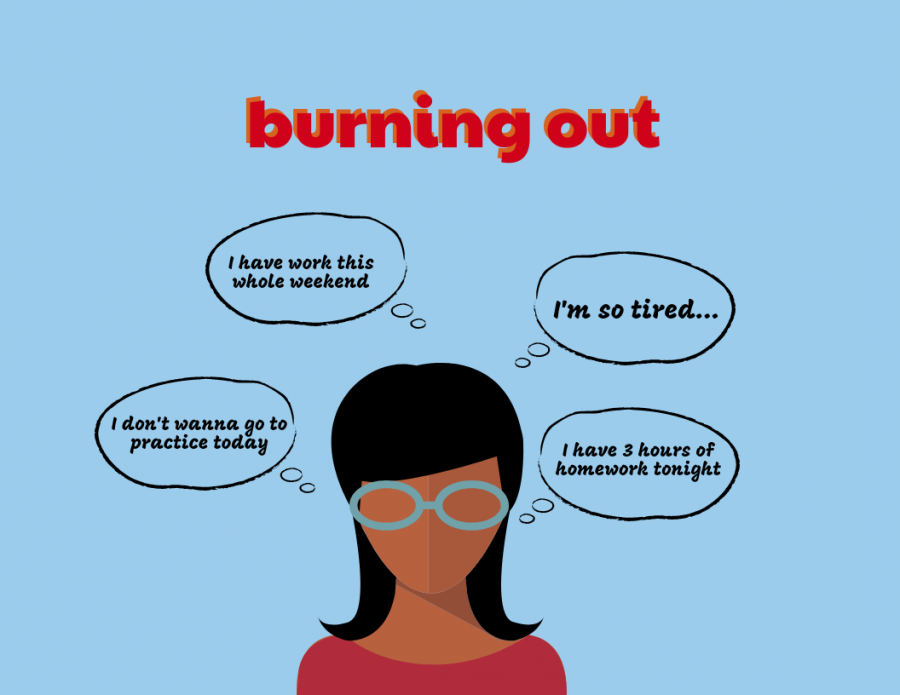Why Have I Burnt Out of School?
Going from one tiresome class to the next during the school day causes a lack of interest and eventually burnout even in the best students.
Burnout is characterized by stress and disinterest in activities and caused by excess amounts of schoolwork and other commitments.
We’ve all heard the cliche complaints about how “school is hard” and how difficult it is to work for seven hours straight. Parents and even some teachers then have the typical response of “I work every day too, you just need to learn to work harder,” or, “why are you wasting your free time procrastinating and being lazy?” Part of the difficulty of the school day is that many students have sports practices, play or instrument rehearsals, work, and hours upon hours of extra homework every single night. But it could be argued that there’s a little more that makes the school day so difficult.
Adults who work at their typical career get the opportunity to do something they chose to do and hopefully enjoy doing. They work on and complete tasks related to the requirements of their chosen profession and are able to spend focused time working on one thing at a time without too much interruption. This is the ideal working scenario, with minimal interruptions and switching of topics/tasks completely even though there may be some multitasking involved. It is not that the work day for a typical adult is not tiring, it is simply that the work they do is focused on a specific, continuous task instead of the alternative: a day at high school.
Dr. Sophie Leroy, business professor at the University of Minnesota, identified a phenomenon she calls attention residue based on research she conducted in a controlled lab setting. This attention residue was identified when subjects in the experiment had trouble switching from one task to another. This was because residue was left behind from the previous task, causing it to affect performance in the next task. Now consider a typical high schooler’s daily schedule: starting at 8:00 am, a day might look like having 50 minutes of English, then math, then a science class, then maybe an art or music class, then a history class, and so on until 3:00. Once a student sits through a lecture and takes notes in American History, they have to somehow turn their brain off of that and switch to a Biology quiz that they studied for the night before but do not quite remember since they just got a whole bunch of information on George Washington. Then after that, they might have to complete a series of Algebra problems, but they are still on the topic of photosynthesis and cannot focus on solving for ‘x.’ This constant switching of completely unrelated topics makes focusing extremely difficult as the day stretches on because that attention residue continues to build throughout the day.
Oftentimes, these classes do not pique students’ interests either. Being forced to sit and listen to a 50 minute lecture and devote one’s entire attention to that lecture is virtually impossible when thinking about the many other homework assignments they have due the next day while still considering the completely different lesson in the last class. In order for a student to want to learn and want to listen, they have to either enjoy what the teacher is saying, how they say it, the environment they learn in, or how long they have to learn. Consider a math classroom with blank, beige walls with no decoration. Now consider that the teacher goes through the notes the same way every day with a monotone voice and little to no peer interaction. Does a student in that class care about what they are learning or even retain the information they were given? Most likely not. They move on to the next 50 minute period of different information being presented in the same way.
Obviously, different variables can have an effect on this. Being able to connect to the teacher, feeling comfortable in a classroom, or understanding and enjoying the lesson being taught helps to alleviate the stressors of such a busy day. But even this does not fix the fact that teenagers are tired of attending full days of an almost endless flow of unrelated and oftentimes uninteresting information. Westminster student Sophie Shaver describes burnout as “the feeling of being so tired after a day of school that you just lay down on your bed and can’t do anything else because you’re so tired and stressed.” Burnout can even turn into more serious problems such as anxiety or depression when not properly taken care of earlier on.
School systems put immense pressure on the lives of students and have done so for years and years. Nothing seems to change even amidst countless cries for help, calls for change, and mental health problems on the rise. In order to alleviate the stressors of a typical day, students should be provided with more opportunity to take classes that interest them. Also, on longer days, teachers should not expect to have their students full attention for 75 minutes straight without some sort of peer interaction, experiment, video, game, or even just a break. Teens want to be active and want to learn if they have the ability to do so in a way they care about. Take for example those “fun” class days…what are they? The days where teens get to make s’mores to demonstrate stoichiometry or tear apart a stuffed animal to liken society to the novel Lord of the Flies or go outside and sit in nature while painting a landscape—those are what stick in a student’s mind and let them learn—not the lecture-based note sheets that are long-forgotten after the test date. Teenagers need to feel cared about and seen if they want to overcome academic burnout, and it’s up to teachers to change their experience and attempt to beat this attention residue.




